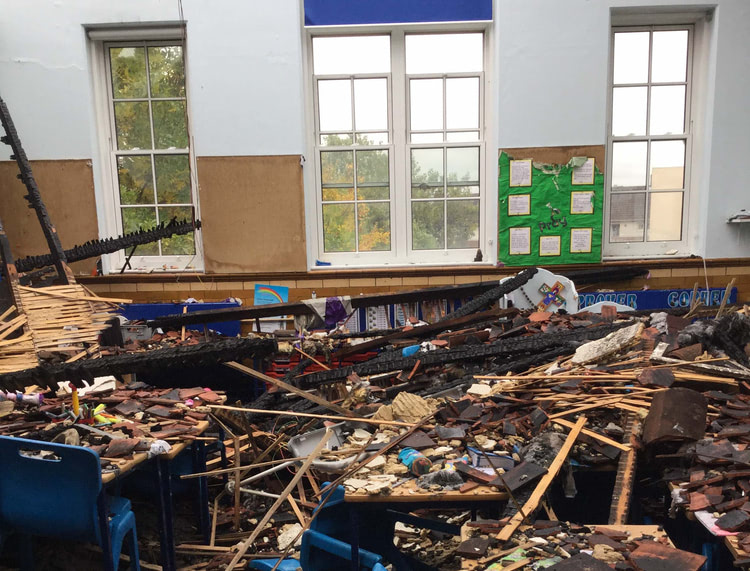Fire risk in schools double that of other non-residential buildings

@Zurich Calls for sprinklers to be made mandatory in England as government pledges £1bn+ school rebuilding programme for England
Schools in England are nearly twice as likely to suffer a blaze as other types of commercial building, according to new research by Zurich Municipal, the leading insurer of schools in the UK.
In the most comprehensive analysis of its kind to date, Zurich analysed the fire risks posed by 26,866 primary and secondary schools in England.
The findings have led Zurich to launch a parliamentary petition (https://petition.parliament.uk/petitions/549558) to urge MPs to change the law on sprinklers in schools.
It found the average school posed a fire risk 1.7[1] times greater than non-residential buildings (with a fire risk score of 0.58 and 0.33 respectively according to Zurich’s model).
When compared to 2.9[2] million non-household properties, schools were also three times more likely to fall into the “high” fire risk category (58% vs 20%), as defined by the study.
Data scientists analysed 33,000 fires from the last six years to identify factors that increase the likelihood of a blaze from which they produced a fire risk score.[3] These factors include listed status, presence of cooking equipment and size of the building itself.
Despite being far riskier than average when it comes to fires, many schools also lack the equipment needed to prevent small fires becoming major disasters. Of more than 1,000 school inspections carried out by Zurich, 66% were rated as having ‘poor’ fixed fire protection systems, such as sprinklers, which are proven to significantly reduce the damage caused by fire. Just 14% were rated ‘good’ or ‘excellent’. A further quarter (24%) were judged ‘poor’ for fire detection measures, such as smoke detectors and fire alarms.[4]
Firefighters have been called to nearly 2,000 school blazes in the last three years. [5] Malfunctioning appliances or equipment, faulty electrics, arson and kitchen blazes are among the leading causes of school fires. Larger fires in schools cost on average £2.8 million to repair and in some cases over £20 million.
Bigger and older schools, including those with a canteen, and secondary schools – which have more complex and dangerous equipment – were identified as particularly at risk. A correlation between poor OFSTED ratings and greater risk of fire was also identified in the analysis.[6]
Whilst sprinklers are compulsory in all new or major refurbished school buildings in Scotland and Wales this is not the case in England. In fact, they are fitted in fewer than one in six new schools.[7]
Tilden Watson, Zurich Municipal’s Head of Education, said: “An alarming number of school buildings pose a high fire risk – yet many are poorly protected against a potential blaze. Unless Ministers bring England into line with other parts of the UK, where sprinklers are mandatory, large fires will continue to blight schools. This is harming children’s education and putting lives at risk.
“Burnt out schools and classrooms cause major disruption to children’s education, with repairs leading to months or even years of upheaval. They also result in the loss of spaces which local communities rely on out of school hours. As well as protecting pupils, sprinklers drastically reduce the extent of damage when there is a blaze, often confining the fire to a single room. This gets children back into schools and classrooms quicker as well as saving taxpayers’ money.
“Countless young people have already had their schooling upended by the coronavirus pandemic. We cannot allow school fires to further disrupt young people’s education, and jeopardise their futures.”
Nick Coombe, Protection Vice Chair and Building Safety Programme Lead for the National Fire Chiefs Council, said: “The case for sprinklers is compelling. Of almost 1,000 fires over five years in buildings where sprinklers were fitted, our research found they controlled or extinguished blazes in 99% of cases. We want to see a greater inclusion of Automatic Fire Suppression Systems (AFSS), including sprinklers, across the built environment. Sprinklers can dramatically reduce fire damage, making the reopening of a school much easier. This not only minimises the disruption to a pupil’s education, but also the impact on their family, the community and the wider education establishment.”
According to Zurich’s analysis, seven million (7,036,327) primary and secondary school children are taught in the 58% of buildings that are a high fire risk.[8]
In June, Boris Johnson pledged £1bn to fund a decade long school rebuilding and repair programme and a further £560m in early August.[9] Based on large fires alone, Zurich estimates that the repair for school fires could hit £320 million over 10 years – a significant portion of the government’s slated investment.[10] Zurich wants the government to ring-fence some of its promised investment to improve the resilience of schools at high risk of fire. Insurers work closely with schools to help them manage their fire risks but the installation of sprinklers minimise the dangers from the outset.
Watson added: “It costs far more to repair fire-ravaged schools than it does to install sprinklers. Even so, cash strapped schools cannot be expected to pick up the bill. The government’s COVID-19 investment is a critical opportunity to ensure schools are more resilient to fire. Unless minsters change the law on sprinklers, much of this funding will be wasted on repairing the fire damage that sprinklers could have easily prevented. The government should also gather and disclose more data on school fires to help fully understand the risks they pose and their wider financial and social impacts.”
Case Study – Sprinklers save Flintshire school from ‘laser cutter’ blaze
Connah’s Quay High School in Flintshire, north Wales, was saved from a potentially disastrous blaze when a laser-cutter caught fire. Around 1,000 pupils had to be evacuated at lunchtime when the fire broke out at the secondary school in June 2019. The school’s sprinkler system quickly extinguished the fire and contained the damage to a single room allowing pupils to return the next day. Emma Dale, Connah’s Quay School Business Manager, said: “Without sprinklers, the damage could have been devastating.” She added: “Sprinklers are a cost saving measure, not an expense. They save the cost of rebuilding and repairing schools, and can pay for themselves in lower insurance premiums.” Speaking at the time North Wales Fire and Rescue Service, said: “This incident clearly highlights the importance of sprinklers in helping to avoid the spread of fire.”












Responses